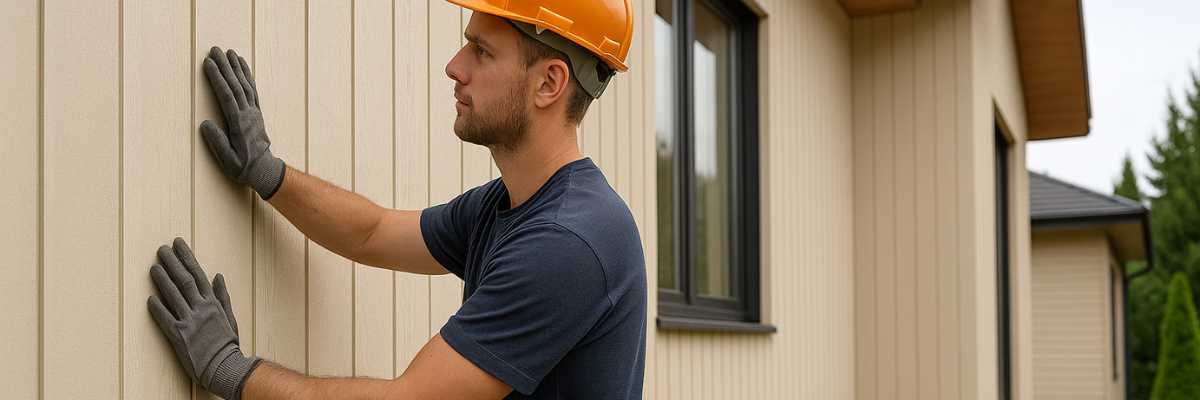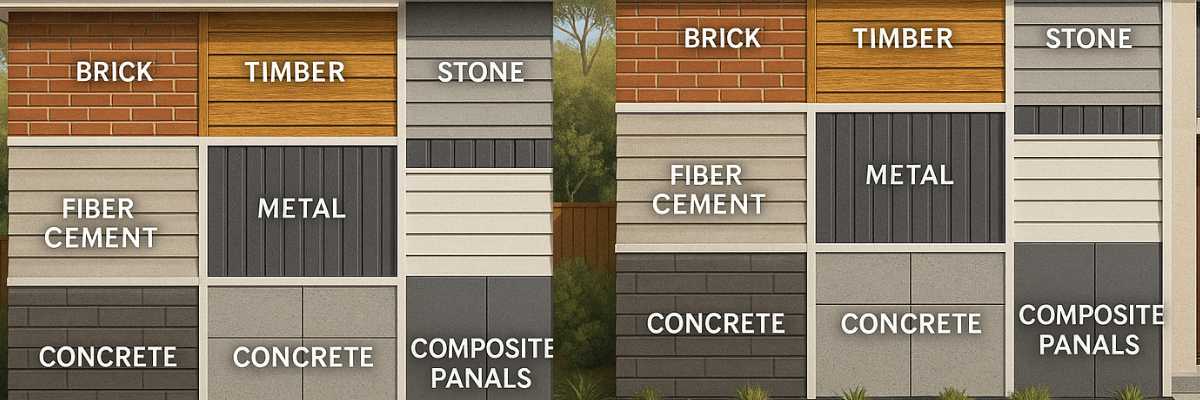Get free quotes within minutes
Cladding Designs to Help Style Your Home

In today’s world, there are numerous options for cladding surfaces and designs to select from. These range from timber/natural stone, composite, bricks, vinyl, aluminium and steel, concrete, ceramics, fibre cement, fibre boards, glass, and metals.
All cladding styles can be installed in a series of creative ways. But cladding is no longer restricted to the walls, now we are cladding our kitchens, ceilings, outdoor decor and fences as well.
In regards to what has been described above, mixing is then just a matter of the preferences once the different types of claddings are given. So, without further ado, let’s explore some ideas for creative cladding design for your future project.
Blending Timber/Composite Cladding Profiles
Group timber and composite cladding profiles are the best combination of traditional materials and innovative materials in today’s construction industry. The use of timber cladding involves creating an outer veneer made of timber thus giving the face of any structure a natural beauty. However, it must be noted that the use of traditional timber can be associated with issues connected to weathering and decay that could lead to damage thus the need for constant maintenance. This is where composite cladding comes in.
Composite cladding is an exceptional type of material that is very useful when it comes to construction since it is very popular and reliable. This type of material is a complex of wooden fibres and varieties of synthetic materials that provide advantages of timber utilised in construction with less risks of moisture, pests, as well as fading. Thus, timber-composite hybrids offer great opportunities for creating designs that combine the characteristically stunning aesthetic appeal of wood and the composite’s durability and resistance.
Mix And Match Cladding Designs
1. Wood and Metal Fusion: Use wooden cedar ceilings and walls and add aluminium brushed finishing in some parts of the house. This mix combines the exquisite look of the raw wood material, especially the texture of the grain pattern with glamour adding the industrial look that is in vogue recently.
2. Brick and Stone Elegance: Stack main walls with red brick and decorate them with stone veneers in bases and corners or the other way around. This mixture results in a timeless and classy appearance recommended for the traditional or rural home.
3. Metal and Glass Modernism: They need to be large to convey the idea of openness, surrounded by dark metal, specifically on the window and door frames. This sort of transparency along with that raw look of metal is ideal for a new-age city feel.
4. Fiber Cement and Wood Harmony: Integrate fibre cement boards as the material for the cladding of the two buildings and horizontal walnut wood as the other material. This blend provides modernity with the appearance of the timber and the durability of the cement fibre material with little requirement for refinishing.
5. Stucco and Metal Contrast: Combine pristine light-coloured stucco walls with black metal accents on the features such as trims and overhangs. This opposition brings a contrast of traditional and modern style that creates the atmosphere of the ‘’modern classic’’ in the interior.
6. Recycled and Sustainable Materials: Depend on the reclaimed wood as the main facade material and reinforce it with selected recycled metal elements. Add more accessories, for instance, use bamboo, which is environmentally friendly and makes a home exterior to be unique.
These examples demonstrate how with the usage of various kinds of cladding, variety and uniqueness the practical side of a house can be achieved. When picking and combining the materials carefully, one can get the look of the chosen style and simultaneously get the functional facade.
How To Choose The Best Cladding Design For Your House?
The selection of the right cladding design that may suit the house is, therefore, a balance between form and function. You can follow the given ideas to select cladding materials and designs for your home.
Evaluate architectural design: It is where one should begin by evaluating the architectural design of your home and the materials that are associated with it. Traditional styled homes should be complemented by materials such as brick and stones while modern styled homes will be complemented by materials such as metals and glass. Rustic homes, for instance, appear adorable with wooden finished exterior walls that bring warmth and texture to the general outlook.
Climate And Maintenance Frequency: Climate and frequency of cladding maintenance are some of the most important factors that have to be considered in the selection of cladding material. For regions that are somewhat warm or have frequent rain mould and water damage can be an issue thus using such materials as fibre cement or treated wood would offer a good defence. In extreme climates or where the building is to be located in a snowy region, one has to use robust materials, which provide insulation and that can stand the test of weather such as metal or stone. Moreover, the level of maintenance one is ready to undertake must be put into consideration.
Cladding Budget: Budget is another factor that seems to be of equal significance since it determines whether or not businesses can afford to implement a change. The cost of cladding varies depending on the material used: stone and high-end metals are more expensive than fibre cement and some varieties of wood. Contrast the costs of purchasing and procuring the material to the costs of installing, as well as the costs of maintenance in the long run so that one can identify the value of the investment.
Building Codes: Last, of all, make sure you are choosing a cladding that was approved for your area’s building codes and homeowner association rules, and don’t hesitate to consult with professionals; this way, you will be able to achieve the best balance of style, utility, and cost.
Unique Cladding Designs for Interior Walls and Ceilings
1. Recycled Materials Cladding:
Concept: Choose materials that are reusable to cover the interior walls. Some examples are using old woods, metals that are retrieved from other locations, recycled glass tiles. These materials do not only or rather have a quite unconventional look and feel, but they also help with sustainability. In addition to having a rather unconventional look that can range from the exquisite to the haphazard, these materials also promote the preservation of the environment.
Benefits: Recycled cladding materials also have interesting textures and colour to them because of their previous usage and thus brings a story into your interiors. They also encourage people to minimise wastage and use of resources in Pierson’s residential area, thus they are also environmentally friendly.
Design Tip: Use different colours of recycled material for a depth and texture feel in the room. For instance, use recycled timber together with recycled glass tiles in a feature wall producing a visually stunning and sustainable room.
2. Living Green Walls:
Concept: It is possible to incorporate the live plants in the interior cladding to help you get the living wall or a green wall. This impressive solution refers to such features as a vertical garden or moss panel allowing introducing parts of nature into a home, which contributes to the stabilisation of air quality and provides an interesting touch in each zone.
Benefits: Living walls work as insulators, purify air and offer a beautiful green sight which turns the dull walls into spectacular feature walls. It also means they assist with noise reduction, something that makes them perfect for use in the bustle of the urban areas.
Design Tip: Opt for plants that are easy to maintain such as moss or succulents especially if one is very busy. If necessary, the irrigation system should be put in place and plant location should be chosen depending on the amount of sunlight the wall receives for plants to be healthy.
3. 3D Wall Panels:
Concept: 3D Wall panels are geometrical patterns or textures on walls which gives the interior an illusion of a three dimensional look. These panels can be Foam, MDF, Plaster etc, and can be painted or left as such, or any other colour.
Benefits: 3D panels generate an impressive look that can be used as an object of discussion or be the centre of attention in a given room. It also allows for rather fun design, and patterns may be ranging from slightly wavy to sharp angles.
Design Tip: Install the 3D panels on one of the walls, do not paste them on all the four walls of the room to prevent over designing. It can be a great idea to make one accent wall with the chosen colour to make the darkness stand out or paint every wall in the room in the corresponding colour to make the darkness less striking.
4. Backlit Cladding:
Concept: Backlighting can be integrated into the cladding design and used to give any architecture a very contemporary look. This can be done with the use of acrylic panels or frosted glass for that matter. The backlighting can help show the texture or the patterns that are in the cladding part and is also a good thing to add dynamics to your walls or ceilings.
Benefits: Glazing makes interiors look attractive and offers a backlit cladding that contributes to creating a rather calming environment. It can be interesting in the cases when used for designing an entryphone, home cinema, or a lounge.
Design Tip: Dial cladding backlit together with other design features like artwork and other structures in order to maximise the overall visibility. This should be light which has the capability of being adjusted in terms of colour temperature for different moods and occasions.
5. Acoustic Cladding:
Concept: Acoustic cladding incorporates specific materials that are purposely type to work best for enhanced sound reinforcement as well as for sound barrier for the general population. Furniture, if also designed according to the principles of acoustics, can also help control sound; this could be the case with chairs with acoustic panels or acoustic curtains on the wall or on the ceiling could also be made of wood perforated with holes.
Benefits: Acoustic cladding mainly comes in handy in home offices, studios or any entertainment room where sound is crucial. It also assists in the development of a more comfortable and easily controlled acoustic environment as well as minimising echos and other ambient noises.
Design Tip: Use acoustic cladding in space that requires noise control or reduced noise such as within hospitals or on airport terminals. This type of panels can be also applied in different colours and with different patterns to add more utility and beauty.
6. Modular Cladding Systems:
Concept: Prefabricated panels or tiles are normally used in the modular cladding systems in that they can be readily fixed and even removed and rearranged if desired. These systems incorporate flexibility and personalization in that you can alter the appearance of interior spaces without major overhauls.
Benefits: Modular cladding systems are also flexible to some extent and its look or design can be changed or remodelled based on the user’s whim. While they are mostly used in wooden designed products, they also come in metal and composite type hence flexibility in the intended look can easily be achieved.
Design Tip: Opt for a modular system with a variety of finishes and patterns since it will enable you to create unique designs. One could explore the use of open shelves that incorporate removable doors or have changeable panelling so that an area’s design can be updated in the future.
Conclusion
The choice of the right cladding design not only enhances the appearance of your home but also provides optimal protection. Each type of cladding, whether it's wall cladding, stone cladding, or vinyl cladding, plays a significant role in improving your home's exterior while offering defence against the elements and maintaining warmth. With careful consideration of these materials and the thoughtful combination of elements, you can achieve a unique, yet functional, appearance that reflects your individuality. Modern cladding solutions allow homeowners to not only transform the look of their homes but also create visually stunning and practical exteriors. To achieve this, hiring professional cladding installers ensures that the design is executed flawlessly, maximizing both the aesthetic and protective benefits of the chosen cladding material.
YOU MIGHT ALSO BE INTERESTED IN

Top 10 Cladding Materials for Australian Homes
Capital Cities
- Cladding Installers Services in Melbourne
- Cladding Installers Services in Brisbane
- Cladding Installers Services in Sydney
- Cladding Installers Services in Adelaide
- Cladding Installers Services in Perth
- Cladding Installers Services in Canberra
- Cladding Installers Services in Hobart
- Cladding Installers Services in Darwin












